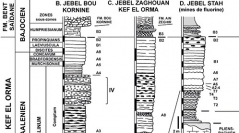

 Comptes Rendus Palevol
7 (4) - Pages 185-194
Comptes Rendus Palevol
7 (4) - Pages 185-194In the Jebel Bou Kornine of Hammam Lif (northern Tunisia), the transition between Lias and Dogger is located in a carbonate formation that is approximately 150 m thick (Kef El Orma Formation). Based on ammonite faunas, its age can be determined as Upper Toarcian (Aalensis Zone) up to Lower Bajocian (Propinquans Zone). Four successive conglomeratic units are recognized in this formation. The two earlier ones are situated in the Uppermost Toarcian (Aalensis Zone, Lugdunensis Subzone), while the later two are in the Opalinum Zone of the Lower Aalenian (Opalinum and Comptum Subzones). These deposits, which associate carbonate-bearing conglomerates with laminated/slumped calcarenites, result from a gravitational flow on a palaeoslope induced by extensive palaeofaults. They testify to a tectonic instability during the Upper Toarcian, causing the formation of two distinct palaeostructural units: the ‘Tunisian trough’ and the ‘Tunisian ridge’ carbonated platform, both belonging to the Maghrebian passive margin of the Tethys. We must insist on the part played, as soon as the Upper Toarcian, by the polyphased tilted-blocks tectonics on the deposition of the different conglomeratic units of the Bou Kornine Jebel.
Lower Jurassic, Middle Jurassic (Aalenian, Bajocian), Northern Tunisia, Tethys, Ammonites, Biostratigraphy, Palaeobiogeography, Paleogeography